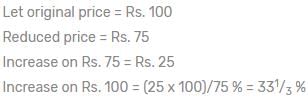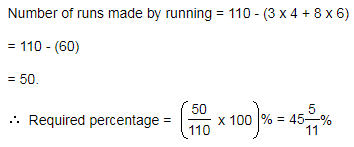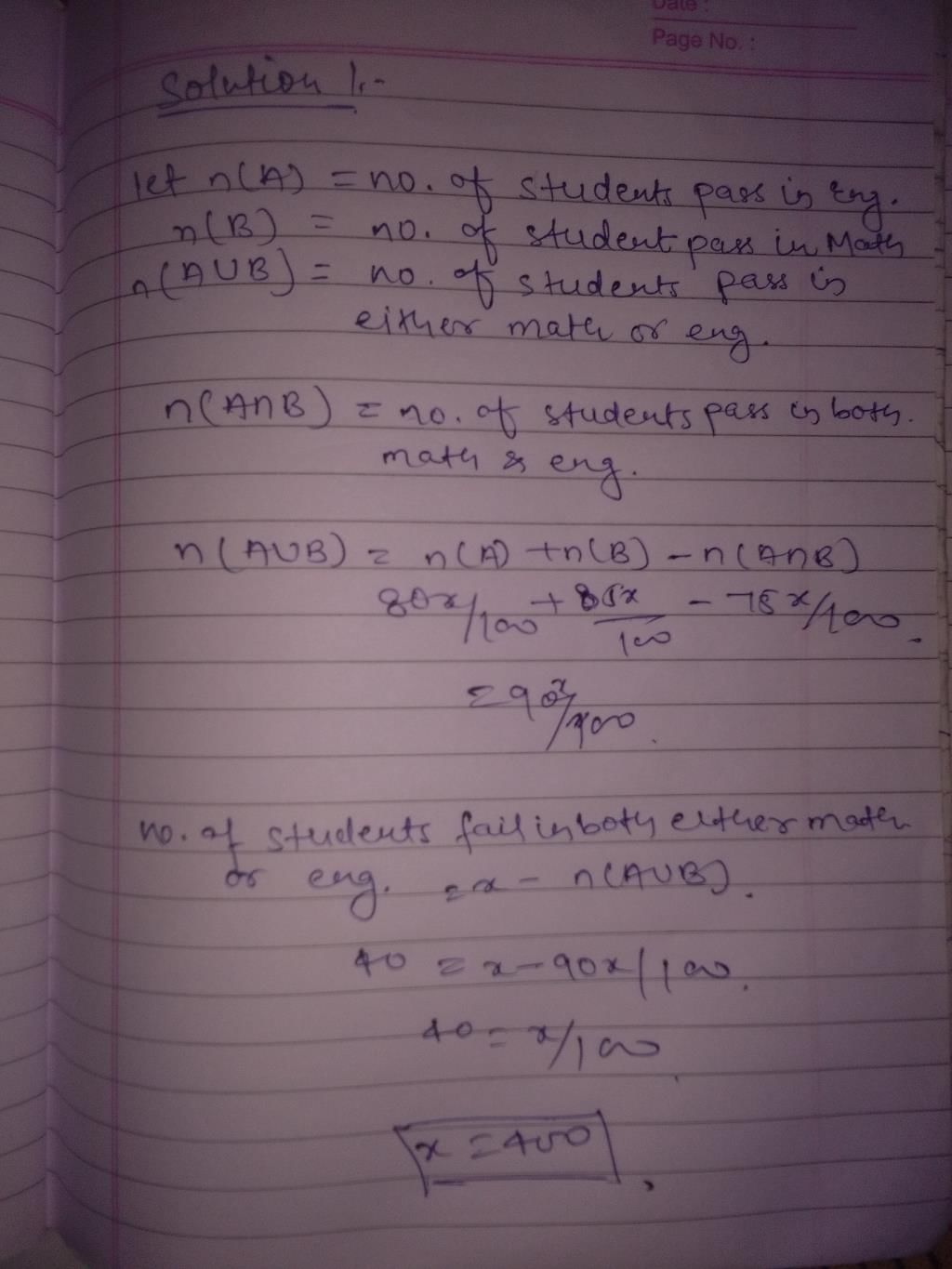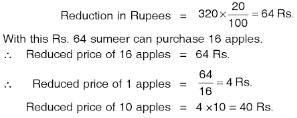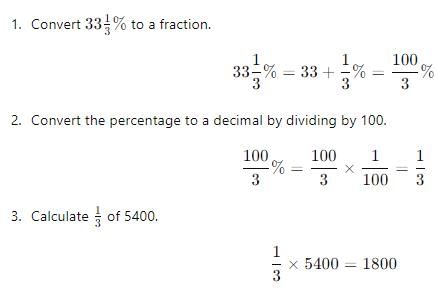All Exams >
Judiciary Exams >
Quantitative Techniques for Judiciary Exam >
All Questions
All questions of Percentage And Its Applications for Judiciary Exams Exam
If the radius of circle is increased by 110% its area is increased by- a)110
- b)301
- c)341
- d)501
Correct answer is option 'C'. Can you explain this answer?
If the radius of circle is increased by 110% its area is increased by
a)
110
b)
301
c)
341
d)
501
|
|
Kavya Saxena answered |
Option ( c) 341 is correct.
Explanation:-
{Let the initial radius of circle = 10 cm
Then, it's area = π r^ 2
= π (10) ^2
= 100 π cm square.
Given, (radius is increased by 110%)
New radius = ( 100+110) % of 10 cm
=> 210% of 10 cm
{ 210 /100 * 10} cm
=> 21 cm
Therefore, area of circle of radius (21) cm
=> π (21) ^2
=> 441 π cm square.
Increase in area= ( 441 π - 100 π ) cm square.
=> 341 cm square. }
=> 341 cm square. }
The value of a machine depreciates 10% annually. If its present value is Rs. 4000, its value 2 years hence will be:- a)Rs. 3000
- b)Rs. 3240
- c)Rs. 3260
- d)Rs. 3280
Correct answer is option 'B'. Can you explain this answer?
The value of a machine depreciates 10% annually. If its present value is Rs. 4000, its value 2 years hence will be:
a)
Rs. 3000
b)
Rs. 3240
c)
Rs. 3260
d)
Rs. 3280

|
Shanaya Sharma answered |
(Present value - 10% of present value)
After one year , 4000 - 400 = 3600
After 2nd year , 3600 - 360 = 3240
The population of a town increases by 5% annually. If it is 15435 now, its population 2 years ago was:- a)13700
- b)14000
- c)14800
- d)15000
Correct answer is option 'B'. Can you explain this answer?
The population of a town increases by 5% annually. If it is 15435 now, its population 2 years ago was:
a)
13700
b)
14000
c)
14800
d)
15000
|
|
Roy Kunal Singh answered |
P (1 + 5/100) ^2 = 15435
p (441/400) = 15435
p = 15435× 400/441 =14000
A student has to secure 35% marks to pass. He gets 650 marks and fails by 50 marks. Find the maximum marks.- a)1000
- b)1500
- c)2000
- d)None
- e)All of the above
Correct answer is option 'C'. Can you explain this answer?
A student has to secure 35% marks to pass. He gets 650 marks and fails by 50 marks. Find the maximum marks.
a)
1000
b)
1500
c)
2000
d)
None
e)
All of the above

|
Rrekha Kumari answered |
Pass marks is 650+50=700
which is 35 % of the total marks
let x be the max marks
then 35% of x = 700
x = 2000
which is 35 % of the total marks
let x be the max marks
then 35% of x = 700
x = 2000
A man’s wages were decreased by 50%. Again the reduced wages were increased by 50%. He has a loss of:- a)0%
- b)0.25%
- c)2.5%
- d)25%
Correct answer is option 'D'. Can you explain this answer?
A man’s wages were decreased by 50%. Again the reduced wages were increased by 50%. He has a loss of:
a)
0%
b)
0.25%
c)
2.5%
d)
25%
|
|
Prakhya Shrivastava answered |
Let 100 be the wages of man if it decreases by 50%, his wages become
100-(50%of 100) = 100-50 =50
Now his wages is 50
when it is increases by 50% then angain his salery become
50+(50%of50) = 50+25 = 75
He has loss of 100-75 = 25
In % = (25×100)/100 = 25%
Thus he has loss of 25%. Hence option (d) is correct.
A number when increased by 37 ½% gives 33. The number is:- a)22
- b)24
- c)25
- d)27
Correct answer is option 'B'. Can you explain this answer?
A number when increased by 37 ½% gives 33. The number is:
a)
22
b)
24
c)
25
d)
27

|
Kavya Sharma answered |
x increased by 37 1/2% ( of x) gives 33, or
x + (37 1/2 % * x) = 33
x + (37.5%x) = 33
1x + (.375x) = 33
1.375x = 33
Divide both sides by 1.375
x = 24
In an examination, Summit got 30% marks and failed by 15 marks. In the same examination, Rohit got 40% marks, which is 35 marks more than the pass marks. Then what is the total marks in the examination?- a)500
- b)250
- c)600
- d)450
Correct answer is option 'A'. Can you explain this answer?
In an examination, Summit got 30% marks and failed by 15 marks. In the same examination, Rohit got 40% marks, which is 35 marks more than the pass marks. Then what is the total marks in the examination?
a)
500
b)
250
c)
600
d)
450

|
Shanaya Sharma answered |
Let the total marks be x.
Sumit got = 30% of x
= 0.3x
Passing marks = 0.3x+15
Rohit got = 40% of x
= 0.4x
Passing marks = 0.4x - 35
Equating both passing marks , we get
0.3x+15 = 0.4x - 35
50 = 0.1x
x = 500
Total marks = 500 , i.e. , option a) 500
Sumit got = 30% of x
= 0.3x
Passing marks = 0.3x+15
Rohit got = 40% of x
= 0.4x
Passing marks = 0.4x - 35
Equating both passing marks , we get
0.3x+15 = 0.4x - 35
50 = 0.1x
x = 500
Total marks = 500 , i.e. , option a) 500
After spending 40% in machinery, 25% in building, 15% in raw material and 5% in furniture, Harilal had a balance of Rs. 1305. The money with him was- a)Rs. 6500
- b)Rs. 7225
- c)Rs. 8700
- d)Rs. 1390
Correct answer is option 'C'. Can you explain this answer?
After spending 40% in machinery, 25% in building, 15% in raw material and 5% in furniture, Harilal had a balance of Rs. 1305. The money with him was
a)
Rs. 6500
b)
Rs. 7225
c)
Rs. 8700
d)
Rs. 1390

|
Shanaya Sharma answered |
Let the money with him be x.
Total expenditure = (40+25+15+5)%*x
= 85%*x
Expenditure + Savings = Total money
85/100x + 1305 = x
x - 0.85x = 1305
0.15x = 1305
x = 8700
In an examination, Summit got 30% marks and failed by 15 marks. In the same examination, Rohit got 40% marks, which is 35 marks more than the pass marks. Then what is the total marks in the examination?- a)500
- b)250
- c)600
- d)450
Correct answer is option 'A'. Can you explain this answer?
In an examination, Summit got 30% marks and failed by 15 marks. In the same examination, Rohit got 40% marks, which is 35 marks more than the pass marks. Then what is the total marks in the examination?
a)
500
b)
250
c)
600
d)
450

|
Shanaya Sharma answered |
Let the total marks be x.
Sumit got = 30% of x
= 0.3x
Passing marks = 0.3x+15
Rohit got = 40% of x
= 0.4x
Passing marks = 0.4x - 35
Equating both passing marks , we get
0.3x+15 = 0.4x - 35
50 = 0.1x
x = 500
Total marks = 500 , i.e. , option a) 500
Sumit got = 30% of x
= 0.3x
Passing marks = 0.3x+15
Rohit got = 40% of x
= 0.4x
Passing marks = 0.4x - 35
Equating both passing marks , we get
0.3x+15 = 0.4x - 35
50 = 0.1x
x = 500
Total marks = 500 , i.e. , option a) 500
At an election a candidate who secured 40% votes and is defeated by the other candidate by a margin of 300 votes. Find the total number of votes recorded.- a)3000
- b)7500
- c)1500
- d)None
- e)All of the above
Correct answer is option 'C'. Can you explain this answer?
At an election a candidate who secured 40% votes and is defeated by the other candidate by a margin of 300 votes. Find the total number of votes recorded.
a)
3000
b)
7500
c)
1500
d)
None
e)
All of the above

|
Notes Wala answered |
The correct option is C.
Vote secured by defeated candidate = 40%
vote secured by winner candidate= 100-40=60%
Difference of vote% = 60-40=20%
So, 20% = 300. 100% = 300×100/20 = 1500
Vote secured by defeated candidate = 40%
vote secured by winner candidate= 100-40=60%
Difference of vote% = 60-40=20%
So, 20% = 300. 100% = 300×100/20 = 1500
The population of a town increases at a rate of 4% per annum. At present it is 37500. What will it be after 2years.- a)40000
- b)40500
- c)40200
- d)None
- e)All of the above
Correct answer is option 'D'. Can you explain this answer?
The population of a town increases at a rate of 4% per annum. At present it is 37500. What will it be after 2years.
a)
40000
b)
40500
c)
40200
d)
None
e)
All of the above
|
|
Dia Mehta answered |
The correct option is D.
P{ (1+R/100)n }
= 37500{ (1+4/100)2 }
= 37500{ (1+1/25)2 }
= 37500{ (26/25)2 }
= 37500{ (676/625) }
= 676*60
= 40560
P{ (1+R/100)n }
= 37500{ (1+4/100)2 }
= 37500{ (1+1/25)2 }
= 37500{ (26/25)2 }
= 37500{ (676/625) }
= 676*60
= 40560
The population of a town increases every year by 4%. If its present population is 50,000, then after 2 years it will be
- a)40000
- b)54080
- c)40200
- d)None
- e)All of the above
Correct answer is option 'B'. Can you explain this answer?
The population of a town increases every year by 4%. If its present population is 50,000, then after 2 years it will be
a)
40000
b)
54080
c)
40200
d)
None
e)
All of the above

|
Shalini Puri answered |
The correct Answer is Option (D)
= 37500*(1+4/100)(1+4/100)
= 37500 * 104/100 * 104/100
= 37500 * 26/25 * 26/25
= 37500 * 676/625
= 676 * 60
= 40560 (ANSWER)
The price of sugar is increased by 20%. If the expenditure is not allowed to be increased, the ratio between the reduction in consumption and the original consumption is- a)1 : 3
- b)1 : 4
- c)1 : 6
- d)1 : 5
Correct answer is option 'C'. Can you explain this answer?
The price of sugar is increased by 20%. If the expenditure is not allowed to be increased, the ratio between the reduction in consumption and the original consumption is
a)
1 : 3
b)
1 : 4
c)
1 : 6
d)
1 : 5
|
|
Ashutosh Gantagharia answered |
Let rate of sugar be 100 per kg
New rate per kg =rupees 120
In rupees 100 sugar purchased=100/120=5/6kg
So reduction in sugar=1-5/6=1/6=1:6
New rate per kg =rupees 120
In rupees 100 sugar purchased=100/120=5/6kg
So reduction in sugar=1-5/6=1/6=1:6
Price of sugar has increased by 60%. How much % a house holder must reduce his consumption of sugar so as not to increase the expenditure?- a)25%
- b)30%
- c)

- d)None
- e)All of the above
Correct answer is option 'C'. Can you explain this answer?
Price of sugar has increased by 60%. How much % a house holder must reduce his consumption of sugar so as not to increase the expenditure?
a)
25%
b)
30%
c)
d)
None
e)
All of the above
|
|
Anaya Patel answered |
The correct option is C as
Let original price of a unit be Rs. 100
Increased price = Rs. 160
Reduction on Rs. 160 = Rs. 60
Reduction on Rs. 100 = 60/160 * 100 = 37.5 %
Let original price of a unit be Rs. 100
Increased price = Rs. 160
Reduction on Rs. 160 = Rs. 60
Reduction on Rs. 100 = 60/160 * 100 = 37.5 %
Rajesh is 40% older thanNeeraj. Find how much % is Neeraj younger than Rajesh.- a)

- b)

- c)25%
- d)None
- e)All of the above
Correct answer is option 'A'. Can you explain this answer?
Rajesh is 40% older thanNeeraj. Find how much % is Neeraj younger than Rajesh.
a)
b)
c)
25%
d)
None
e)
All of the above

|
Crafty Classes answered |
Given:
- Rajesh is 40% older than Neeraj.
We need to find out how much percentage younger Neeraj is compared to Rajesh.
Step 1: Let Neeraj's age be N.
- Since Rajesh is 40% older, Rajesh's age will be:
Rajesh’s age = N + 40% of N = N + 0.4N = 1.4N
Step 2: Find the percentage by which Neeraj is younger than Rajesh.
- The difference in age between Rajesh and Neeraj is:
Difference in age = 1.4N − N = 0.4N - Now, to find how much younger Neeraj is as a percentage of Rajesh's age, we use the formula:

Substituting the values:

Neeraj is 28.57% younger than Rajesh, which matches the fraction
Thus, the correct answer is Option A:

Neeraj is 28.57% younger than Rajesh, which matches the fraction

Thus, the correct answer is Option A:

A student who gets 36% of marks, fails by 32 marks. Another candidate who gets 45% marks gets 40 marks more than are necessary for passing. Find the maximum marks.
- a)1600
- b)600
- c)400
- d)None
- e)All of the above
Correct answer is option 'B'. Can you explain this answer?
A student who gets 36% of marks, fails by 32 marks. Another candidate who gets 45% marks gets 40 marks more than are necessary for passing. Find the maximum marks.
a)
1600
b)
600
c)
400
d)
None
e)
All of the above
|
|
Aarav Sharma answered |
Given:
- A student who gets 36% of marks, fails by 32 marks.
- Another candidate who gets 45% marks gets 40 marks more than are necessary for passing.
To find:
- Maximum marks
Solution:
Let the maximum marks be x.
From the given data,
- The first student gets 36% marks and fails by 32 marks. So,
- Marks obtained by the first student = 36% of x
- Marks required to pass = (100% - 36%) of x = 64% of x
- According to the question, the first student fails by 32 marks. So,
- 36% of x - 64% of x = 32
- -28% of x = 32
- x = 32/(-28%) = 114.28 ≈ 114 (rounded off to the nearest integer)
- The second student gets 45% marks and gets 40 marks more than are necessary for passing. So,
- Marks obtained by the second student = 45% of x
- Marks required to pass = (100% - 45%) of x = 55% of x
- According to the question, the second student gets 40 marks more than are necessary for passing. So,
- 45% of x - 55% of x = 40
- -10% of x = 40
- x = 40/(-10%) = 400
Therefore, the maximum marks are 400.
Hence, option B is the correct answer.
- A student who gets 36% of marks, fails by 32 marks.
- Another candidate who gets 45% marks gets 40 marks more than are necessary for passing.
To find:
- Maximum marks
Solution:
Let the maximum marks be x.
From the given data,
- The first student gets 36% marks and fails by 32 marks. So,
- Marks obtained by the first student = 36% of x
- Marks required to pass = (100% - 36%) of x = 64% of x
- According to the question, the first student fails by 32 marks. So,
- 36% of x - 64% of x = 32
- -28% of x = 32
- x = 32/(-28%) = 114.28 ≈ 114 (rounded off to the nearest integer)
- The second student gets 45% marks and gets 40 marks more than are necessary for passing. So,
- Marks obtained by the second student = 45% of x
- Marks required to pass = (100% - 45%) of x = 55% of x
- According to the question, the second student gets 40 marks more than are necessary for passing. So,
- 45% of x - 55% of x = 40
- -10% of x = 40
- x = 40/(-10%) = 400
Therefore, the maximum marks are 400.
Hence, option B is the correct answer.
On decreasing the price of TV set by 30%, its sale is increased by 20%. What is the effect on the revenue received by the shopkeeper?- a)10% increase
- b)10% decrease
- c)16% increase
- d)16% decrease
Correct answer is option 'D'. Can you explain this answer?
On decreasing the price of TV set by 30%, its sale is increased by 20%. What is the effect on the revenue received by the shopkeeper?
a)
10% increase
b)
10% decrease
c)
16% increase
d)
16% decrease

|
Kavya Sharma answered |
Lets take the orignal price as 100. Then on decreasing the price by 30% we get= 70. Now the sale is increased by 20%=84 (20% of 70 or 20/100*70= 14 now 70+14=84) So we can say that Cp=100 and Sp=84 Thats loss as cp is bigger. Loss=16 Loss%=16/100*100 =16%
In Mathematics exam, a student scored 30% marks in the first paper, out of the total of 180. How much should he score in second paper out of a total of 150, if he is to get an overall average of at least 50%- a)74%
- b)76%
- c)70%
- d)80%
Correct answer is option 'A'. Can you explain this answer?
In Mathematics exam, a student scored 30% marks in the first paper, out of the total of 180. How much should he score in second paper out of a total of 150, if he is to get an overall average of at least 50%
a)
74%
b)
76%
c)
70%
d)
80%

|
Sameer Rane answered |
∵ 30% of 180 + N% of 150 = 50% of (180 + 150)
⇒ 54 + (N x 150)/100 = 165
⇒ 3N/2 = 111
∴ N = (111 x 2) / 3 =74
Petrol prices are reduced by 20%. Find by how much percent a vehicle owner must increase his consumption of petrol so as not to decrease his expenditure of petrol.- a)20%
- b)25%
- c)42%
- d)None
- e)All of the above
Correct answer is option 'B'. Can you explain this answer?
Petrol prices are reduced by 20%. Find by how much percent a vehicle owner must increase his consumption of petrol so as not to decrease his expenditure of petrol.
a)
20%
b)
25%
c)
42%
d)
None
e)
All of the above

|
Future Foundation Institute answered |
Given:
- Petrol prices are reduced by 20%.
- We need to find by how much percentage a vehicle owner must increase his consumption so that his expenditure does not decrease.
Step 1: Understanding the situation.
If the price of petrol has decreased by 20%, it is now 80% of what it was before. To keep the expenditure the same, the vehicle owner must increase his consumption so that the total expenditure remains constant.
Step 2: Formula to calculate the percentage increase in consumption:
The formula to calculate the percentage increase required is:

In this case, the reduction in price is 20%, or 0.20.

In this case, the reduction in price is 20%, or 0.20.
Step 3: Substituting the values into the formula:
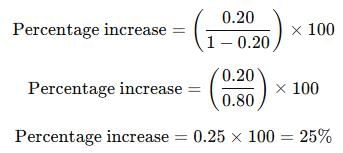
The vehicle owner must increase his consumption by 25% to maintain the same expenditure on petrol.

The vehicle owner must increase his consumption by 25% to maintain the same expenditure on petrol.
The price of milk has risen by 75%. Find by how much percent a house holder must reduce his consumption so as not to increase his expenditure.- a)

- b)

- c)

- d)None
- e)All of the above
Correct answer is option 'C'. Can you explain this answer?
The price of milk has risen by 75%. Find by how much percent a house holder must reduce his consumption so as not to increase his expenditure.
a)
b)
c)
d)
None
e)
All of the above

|
Crafty Classes answered |
Given:
- The price of milk has increased by 75%.
- We need to find by what percentage a householder must reduce his consumption so that his expenditure does not increase.
Step 1: Understanding the situation.
If the price of milk has risen by 75%, the price is now 1.75 times what it was before. To keep the expenditure the same, the householder must reduce his consumption in such a way that the total expenditure remains constant.
Step 2: Formula to calculate the percentage reduction in consumption:
The formula to calculate the percentage reduction required is:

In this case, the increase in price is 75%, or 0.75.

In this case, the increase in price is 75%, or 0.75.
Step 3: Substituting the values into the formula:
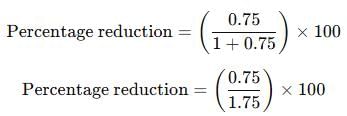
Percentage reduction = 0.4286 × 100 = 42.86%

Percentage reduction = 0.4286 × 100 = 42.86%
Step 4: Simplifying:
The reduction in consumption should be approximately
The householder must reduce his consumption by
Therefore, the correct answer is Option C.

The householder must reduce his consumption by

Therefore, the correct answer is Option C.
At an election a candidate secures 40% votes and is defeated by the other candidate by a majority of 2020 votes. Find the total number of votes polled.- a)9900
- b)10000
- c)10100
- d)None
- e)All of the above
Correct answer is option 'C'. Can you explain this answer?
At an election a candidate secures 40% votes and is defeated by the other candidate by a majority of 2020 votes. Find the total number of votes polled.
a)
9900
b)
10000
c)
10100
d)
None
e)
All of the above
|
|
Sajal Bdw answered |
A candidate who was defeated got 40% of vote therefore it can be concluded that it the candidate who won the election got 60% of vote
So now let's consider total number of votes are x So according to question we have
60x÷100-40x÷100=2020
or,20x÷100=2020
or,x=10100 Therefore the answer
So now let's consider total number of votes are x So according to question we have
60x÷100-40x÷100=2020
or,20x÷100=2020
or,x=10100 Therefore the answer
A reduction of 20% in the price of rice enables a man to buy 10 kg more rice for Rs. 1600. Find the reduced price of rice per kg.- a)Rs. 25
- b)Rs. 12
- c)Rs. 32
- d)None
- e)All of the above
Correct answer is option 'C'. Can you explain this answer?
A reduction of 20% in the price of rice enables a man to buy 10 kg more rice for Rs. 1600. Find the reduced price of rice per kg.
a)
Rs. 25
b)
Rs. 12
c)
Rs. 32
d)
None
e)
All of the above
|
|
Sajal Bdw answered |
Let the original price of rice = Rs. x/kg
New price = Rs 4x/5 kg
According to question,
[1600/(4x/5)] - (1600/x) = 10
=>(8000/4x) - (1600/x) = 10
=>40x = 1600 {By solving above equation}
=>x = 40
Hence the original price of rice is 40 rupees per kg.
for the reduced price equal to=(4/5)×40
=32
therefore the new price of rice is 32 rupees per kg
HENCE OPTION C IS THE ANSWER
New price = Rs 4x/5 kg
According to question,
[1600/(4x/5)] - (1600/x) = 10
=>(8000/4x) - (1600/x) = 10
=>40x = 1600 {By solving above equation}
=>x = 40
Hence the original price of rice is 40 rupees per kg.
for the reduced price equal to=(4/5)×40
=32
therefore the new price of rice is 32 rupees per kg
HENCE OPTION C IS THE ANSWER
In an examination, it is required to get 36% of maximum marks to pass. A student got 113 marks and was declared fail by 85 marks. The maximum marks are- a)500
- b)550
- c)640
- d)1008
Correct answer is option 'B'. Can you explain this answer?
In an examination, it is required to get 36% of maximum marks to pass. A student got 113 marks and was declared fail by 85 marks. The maximum marks are
a)
500
b)
550
c)
640
d)
1008

|
Avantika Chakraborty answered |
36% of x = 113 + 85
= 198
x = 198 * 100/36
= 550
Max marks= 550
In an election between two candidates, one got 55% of the total valid votes, 20% of the votes were invalid. If the total number of votes was 7500, the number of valid votes that the other candidate got, was:
- a)2700
- b)2900
- c)3000
- d)3100
Correct answer is option 'A'. Can you explain this answer?
In an election between two candidates, one got 55% of the total valid votes, 20% of the votes were invalid. If the total number of votes was 7500, the number of valid votes that the other candidate got, was:
a)
2700
b)
2900
c)
3000
d)
3100

|
Ishani Rane answered |

If two numbers are respectively 20% and 50% of a 3rd number then what % is the 1st number of the 2nd one?- a)10
- b)20
- c)30
- d)40
Correct answer is option 'D'. Can you explain this answer?
If two numbers are respectively 20% and 50% of a 3rd number then what % is the 1st number of the 2nd one?
a)
10
b)
20
c)
30
d)
40
|
|
Ravi Singh answered |
Let third number is x.
Then first no. 20% of x= 

Second number = 50% of x = 

Percent of first number of second number,

A student has to secure 35% marks to pass. He gets 650 marks and fails by 50 marks. Find the maximum marks.- a)1000
- b)1500
- c)2000
- d)None
- e)All of the above
Correct answer is option 'C'. Can you explain this answer?
A student has to secure 35% marks to pass. He gets 650 marks and fails by 50 marks. Find the maximum marks.
a)
1000
b)
1500
c)
2000
d)
None
e)
All of the above
|
|
Aarav Sharma answered |
Problem Solving Strategy:
Let the maximum marks be x.
According to the given question,
35% of x = 650 + 50
= 700
Hence, we can find x by using the formula:
35/100 * x = 700
x = 2000
Solution:
Therefore, the maximum marks are 2000. Hence, the correct answer is option (c).
Let the maximum marks be x.
According to the given question,
35% of x = 650 + 50
= 700
Hence, we can find x by using the formula:
35/100 * x = 700
x = 2000
Solution:
Therefore, the maximum marks are 2000. Hence, the correct answer is option (c).
In a college election, a candidate secured 62% of the votes and is elected by a majority of 144 votes. The total number of votes polled is- a)600
- b)800
- c)925
- d)1200
Correct answer is option 'A'. Can you explain this answer?
In a college election, a candidate secured 62% of the votes and is elected by a majority of 144 votes. The total number of votes polled is
a)
600
b)
800
c)
925
d)
1200

|
Avantika Chakraborty answered |
∵ (62% of N - 38% of N) =144
⇒ 24% of N = 144
∴ N = (144 x 100)/24 = 600
In an examination, 42% students failed in Hindi and 52% failed in English. If 17% failed in both the subjects, the percentage of those who passed in both the subject is- a)23%
- b)27%
- c)34%
- d)40%
Correct answer is option 'A'. Can you explain this answer?
In an examination, 42% students failed in Hindi and 52% failed in English. If 17% failed in both the subjects, the percentage of those who passed in both the subject is
a)
23%
b)
27%
c)
34%
d)
40%
|
|
Aarav Sharma answered |
Solution:
Given,
Percentage of students failed in Hindi = 42%
Percentage of students failed in English = 52%
Percentage of students failed in both the subjects = 17%
Let's assume the total number of students appeared for the examination be 100.
Number of students failed in Hindi = 42% of 100 = 42
Number of students failed in English = 52% of 100 = 52
Number of students failed in both subjects = 17% of 100 = 17
Now, we need to find the percentage of students who passed in both subjects.
Number of students who failed in at least one subject = Number of students failed in Hindi + Number of students failed in English - Number of students failed in both subjects
= 42 + 52 - 17 = 77
Number of students who passed in both subjects = Total number of students - Number of students who failed in at least one subject
= 100 - 77 = 23
Percentage of students who passed in both subjects = (Number of students who passed in both subjects / Total number of students) * 100%
= (23/100) * 100%
= 23%
Therefore, the percentage of students who passed in both subjects is 23%, which is option A.
Given,
Percentage of students failed in Hindi = 42%
Percentage of students failed in English = 52%
Percentage of students failed in both the subjects = 17%
Let's assume the total number of students appeared for the examination be 100.
Number of students failed in Hindi = 42% of 100 = 42
Number of students failed in English = 52% of 100 = 52
Number of students failed in both subjects = 17% of 100 = 17
Now, we need to find the percentage of students who passed in both subjects.
Number of students who failed in at least one subject = Number of students failed in Hindi + Number of students failed in English - Number of students failed in both subjects
= 42 + 52 - 17 = 77
Number of students who passed in both subjects = Total number of students - Number of students who failed in at least one subject
= 100 - 77 = 23
Percentage of students who passed in both subjects = (Number of students who passed in both subjects / Total number of students) * 100%
= (23/100) * 100%
= 23%
Therefore, the percentage of students who passed in both subjects is 23%, which is option A.

- a)707
- b)717
- c)7007
- d)None
- e)All of the above
Correct answer is option 'C'. Can you explain this answer?
a)
707
b)
717
c)
7007
d)
None
e)
All of the above

|
EduRev CLAT answered |
FractionPercent 7/8 = 87.5 %
7/8 x 8008 = 7007
7/8 x 8008 = 7007

- a)110
- b)1100
- c)1111
- d)None
- e)All of the above
Correct answer is option 'B'. Can you explain this answer?
a)
110
b)
1100
c)
1111
d)
None
e)
All of the above
|
|
Sajal Bdw answered |
33 1/3% of 3300
=[(100/3)/100]×3300
=1100
hence option B is the correct answer
=[(100/3)/100]×3300
=1100
hence option B is the correct answer

- a)1414
- b)5600
- c)700
- d)None
- e)All of the above
Correct answer is option 'D'. Can you explain this answer?
a)
1414
b)
5600
c)
700
d)
None
e)
All of the above

|
Crafty Classes answered |
Given:

This is a percentage problem, where we need to calculate
Step 1: Convert the mixed fraction to an improper fraction


This is a percentage problem, where we need to calculate

Step 1: Convert the mixed fraction to an improper fraction

Step 2: Convert the percentage to a decimal
To convert a percentage to a decimal, divide by 100:


Step 3: Multiply by 1600
Now, calculate:
0.875 × 1600 = 1400
None of the given options match the correct answer of 1400.
Therefore, the correct option is: D: None
Chapter doubts & questions for Percentage And Its Applications - Quantitative Techniques for Judiciary Exam 2025 is part of Judiciary Exams exam preparation. The chapters have been prepared according to the Judiciary Exams exam syllabus. The Chapter doubts & questions, notes, tests & MCQs are made for Judiciary Exams 2025 Exam. Find important definitions, questions, notes, meanings, examples, exercises, MCQs and online tests here.
Chapter doubts & questions of Percentage And Its Applications - Quantitative Techniques for Judiciary Exam in English & Hindi are available as part of Judiciary Exams exam.
Download more important topics, notes, lectures and mock test series for Judiciary Exams Exam by signing up for free.
Quantitative Techniques for Judiciary Exam
46 videos|71 docs|95 tests
|

Contact Support
Our team is online on weekdays between 10 AM - 7 PM
Typical reply within 3 hours
|
Free Exam Preparation
at your Fingertips!
Access Free Study Material - Test Series, Structured Courses, Free Videos & Study Notes and Prepare for Your Exam With Ease

 Join the 10M+ students on EduRev
Join the 10M+ students on EduRev
|

|
Create your account for free
OR
Forgot Password
OR
Signup to see your scores
go up
within 7 days!
within 7 days!
Takes less than 10 seconds to signup

